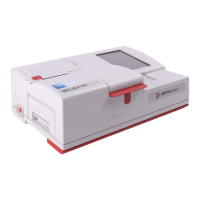Operator’s Manual – OPTI CCA-TS2 9-13
9 OPERATING PRINCIPLES
9.5.10 Interferences
Selected substances endogenous and exogenous to human blood were tested for interference in
accord with CLSI EP7-A2
5
. These substances were selected on the basis of their optical absorbance
or uorescence properties likely to affect the optical signal measured by the OPTI CCA-TS2, or the
optical properties of the sensor measured by the analyzer. To cause interference to the optical sensors,
the substances must be highly mobile (low molecular weight) and highly colored, in order to penetrate
the optode membrane barriers quickly (within the 90 sec. measurement interval), and then strongly
absorb light or emit light of the proper color. To cause interference to the tHb and SO
2
reectance
measurements, the substances must strongly absorb or scatter red or infrared light, relative to normal
whole blood.
The following substances were tested in whole blood at the CLSI-recommended test level or higher,
and showed no interference to any measured analyte, including blood gas, electrolytes, and tHb/SO
2
:
Bile Acids (30 µmol/dL)
Bilirubin (40 mg/dL)
Beta-Carotene (3.0 mg/dL)
Hemolysis (10%) During hemolysis K
+
is released from the blood cells thereby
increasing the measured K
+
. In the same manner, protein released
from the cells binds ionized Ca
++
and decreases the concentration.
While an accurate value is reported, it will reect the actual changes
caused by hemolysis.
Lipemia (equivalent to 3000 mg/dL triglycerides)
Elevated white blood cell count (30,000 WBC/µL)
The following substances were tested in plasma at the CLSI-recommended test level or higher, and
showed no interference to blood gas and electrolyte analytes:
Coumadin (Warfarin) (12 mg/dL)
Dicumarol (Dicoumarin) (11 mg/dL)
Procain (Novacaine) (13 mg/dL)
Acetaminophen (Paracetamol) (20 mg/dL)
The OPTI CCA-TS2 system was evaluated for the interference of sample temperature on measurement
(iced samples). No measurable sensitivity to sample temperature was found.
For more detailed information on interferences, see analyte section of this Operator’s Manual.
5
Clinical and Laboratory Standards Institute (CLSI). Interference Testing in Clinical Chemistry;
Approved Guideline - 2nd Edition. CLSI document EP7-A2. CLSI, Wayne, PA, 2005

